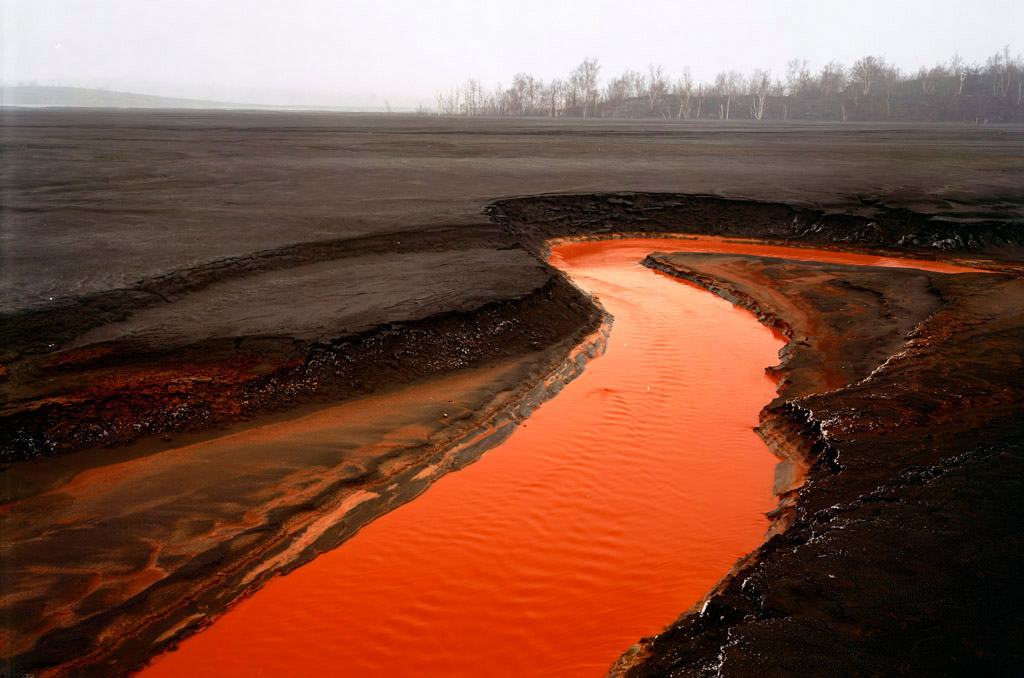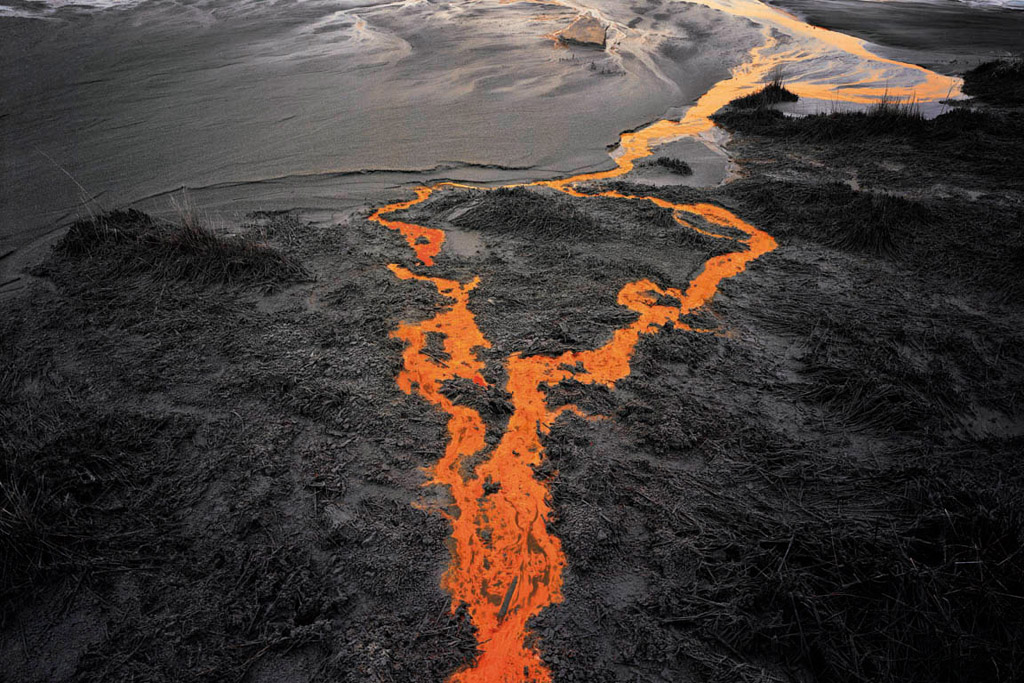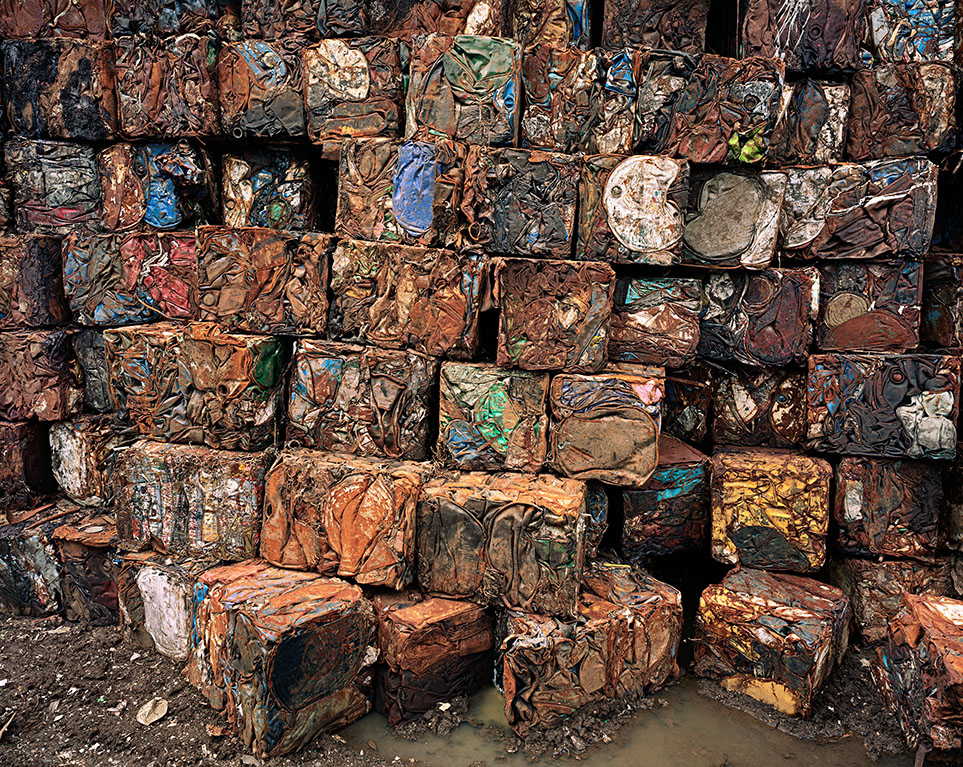Edward Burtynsky
Edward Burtynsky is a Canadian photographer whose work documents the impact of industry on the environment. Most of his work is quite large, high resolution prints taken with a large-format camera that capture bleak but visually rich vistas of industrial wastelands – sometimes the aftereffects, sometimes ongoing industrial sites. He’s quite celebrated – he has received the Order of Canada among other awards and was the subject of an award-winning feature-length documentary, Manufactured Landscapes (2006). I saw a selection of his work in 2004 at the Musée d’art Contemporain in Montreal, and was quite simply awestruck.

Burning Tire Pile # 1
Near Stockton, California 1999
The beauty of his works is the first thing that strikes you as you meander through the galleries. He works in medium-to-large formats: 30″ x 40″ or 40″ x 50″ prints that sit proud on a wall. They are powerful in a way akin to the early natural landscapes of Carleton Watkins or Eadweard Muybridge, who in the mid- to late-19th century strove to honour the majesty of nature through their photographs, choosing viewpoints that purposefully dwarfed man under the immensity of rolling mountains and the like in the forefront. Burtynsky’s scenes are similarly awing for the sheer size of the objects or locations he photographs; his images of comparatively diminutive trains cutting across vertiginous, humongous precipices in Ontario or of miniature workers taking apart giant defunct ships in Bangladesh demonstrate the smallness of the human race.
One main and essential difference, though, is that the very subject of these works is the fact that man has seized power over these places. None of the locations he chooses as subjects are so-called pure, unadulterated nature; they are all areas particularly dominated by people purposefully striving toward economic gain. The striking vibrancy of the fluorescent orange nickel streams left over by a mine in Sudbury, Ontario, exist as photographed because they were extracted and left there by man. The mesmerizing geometric patterns made by the striations in the earth’s marble shield in Italy exist because man has cut through it that way to sell it in portions. The giant tire mountains of California, or the crushed metal compounds, exist because of what man has made, used and disposed of from the oil he’s sucked out of the earth or the metal he’s pillaged from its soil.
– Isa Tousignant, Hour Community 2004

Sudbury Nickel Tailings no. 34
I think the pieces that struck me the most were the tailings of a nickel mine in Sudbury. These pieces are so unlike what we expect to see on this planet that they almost read as abstract colour fields.

Sudbury Nickel Tailings no.31
The stark contrast of the swaths of reddish orange in that black deathscape are only plausible because you know these are photographs. This not to downplay the impact of more recognizable scenes like the tire dumps, abandoned quarries, or salvage yards – if anything, they serve to heighten the horror of these scenes of devastation that most of us sort of realize are going on all the time all over the world but we carefully file away with other unpleasant realities.

Rock of Ages # 4,
Abandoned Section, Adam-Pirie Quarry, Barre, Vermont, 1991
A quite extensive selection of Burtynsky’s work including photographs of salvage yards, oil spills, dumps, tailings, quarries, and much more can be seen on his site. If you are even fleetingly concerned about humanity’s impact upon the natural environment you really must make the time and take a look. Whether Burtynsky’s ouevre is a cautionary tale for future generations or a document of our planet’s destruction remains to be seen.

Densified Oil Drums No. 4,
Hamilton, Ontario 1997
Nature transformed through industry is a predominant theme in my work. I set course to intersect with a contemporary view of the great ages of man; from stone, to minerals, oil, transportation, silicon, and so on. To make these ideas visible I search for subjects that are rich in detail and scale yet open in their meaning. Recycling yards, mine tailings, quarries and refineries are all places that are outside of our normal experience, yet we partake of their output on a daily basis.
These images are meant as metaphors to the dilemma of our modern existence; they search for a dialogue between attraction and repulsion, seduction and fear. We are drawn by desire – a chance at good living, yet we are consciously or unconsciously aware that the world is suffering for our success. Our dependence on nature to provide the materials for our consumption and our concern for the health of our planet sets us into an uneasy contradiction. For me, these images function as reflecting pools of our times.
– Edward Burtynsky, Artist’s Statement



I think men were condemned to die under the rubble they created .Sometimes these creations are ugly.vested interests give a damn for the sake of their immediate gains.